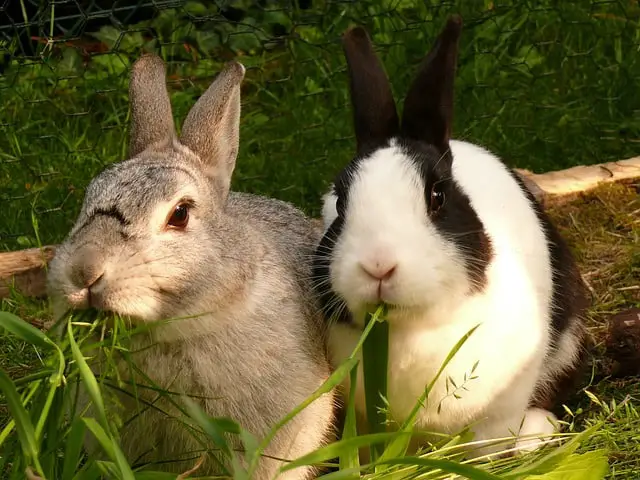
Can you let your apartment rabbit have babies?
Answer the following questions honestly:
- Will you or your family have time to occupy yourself; correctly from the doe during i gestation, then from the young?
- Does the time of gestation (; (one month) and the rearing of the young ((two months) not fall (precisely at the time of holidays, a move, or a period of intense professional activity? In this case, it would be better to postpone this project until later.
- Is your cage big enough for the doe to have enough room next to the shelter where she will have given birth, for her and her cubs?
- If you want to keep one or more little ones, you will need to plan their accommodation in good time ( new cage or hutch ).
- If you intend to donate the little ones, think about it in advance (family, pet stores, animal welfare associations). It is not always easy to find good hands to welcome the little ones.
- Talk to your children in advance about your intention to give the little ones, otherwise there will be tears.
- If you want to breed multiple litters, you need to learn more, and have plenty of time and space. If you only have one apartment with a balcony, that is insufficient. If you really want to practice breeding, it is better to join an association of rabbit breeders. Here you will find advice from experienced breeders who will help you. To practice rabbit breeding, you need to learn about heredity and breeds and visit the exhibits.
Selecting appropriate rabbits for breeding
You will have to ensure that the future parents are healthy and mature. Rabbits are ready to reproduce around twelve weeks, and then you have to separate the males and females of the same litter. But that doesn’t mean you have to mate them right away. If you cover your rabbit too early, its risks irreparable damage.
If you have dwarf rabbits, consider racial traits. The colors, on the other hand, can be crossed. You will have some “multicolored” surprises which can be lovely.
For standardized breeding, take only rabbits of the same pure breed; then check that they are well tattooed by the breeder and registered.
What is the right age for breeding for rabbits:
For small breeds, wait at least six months, seven for medium breeds, and eight for large breeds. These are only indicative ages, we must take into account the development of each individual. Recommendation: do not multiply disorderly experiments with rabbits that are too different. Take a male preferably a little smaller.
When and how often does the female rabbit have heat cycle:
Heat is when an animal is sexually aroused and ready for mating. For cats and bitches these are limited times, while the domestic rabbit is fertile most of the year. Sometimes the mere presence of a male nearby is enough for the female to be in heat. To the point that she will give all the visible signs of pregnancy. She then begins to collect straw to fill the shelter, does not stop scratching with excitement in her litter, and may even become aggressive with the other females in the group. Make no mistake about it! Only the visibly rounder belly, the swollen nipples and the down that she tears from the belly to line the nest just before the term will allow you to recognize a pregnancy with certainty.
Mating of the Rabbits
Let the rabbits loose and allow them to mate. Let nature take over
Pregnancy of the Rabbit
Gestation in rabbits lasts for 28 to 31 days from the day of fertilization. If the litter is particularly big, the rabbit can sometimes give birth earlier. If there are only two babies, and especially if they are large enough, birth may not occur until the thirty-fifth day. But babies that have been carried beyond term are often stillborn.
The signs: during gestation, the female rabbit starts to scratch nervously in its litter. She turns everything around and tries to build a nest in the far corner of the cage. She is more nervous than usual, fearful, and has a tendency to scratch. In the last days, she remains lying down.
Spontaneous abortion of fetuses: this is still an unexplained phenomenon. This form of birth control is observed in all rabbits, wild or domestic. The researchers did not find any disease or hormonal disturbance at the origin of this process. It is assumed that these hypersensitive animals are able to stop gestation when the environment is too aggressive. All the more reason to surround the rabbit with all your care.
Delivery of babies of Rabbit
About ten days before the scheduled term, change the litter and hay in the cage, and put a crate there if you do not have a shelter. Almost all rabbits will get to work right away. The rabbit’s instinct drives her to give birth to her young in a dark corner where she can hide. The shelter will also protect the little ones from the cold and drafts and prevent them from going out too early.
A few days before birth, the doe begins to tear the down from the belly to line its nest. She often stays stretched out, and her round belly will not leave you in doubt: it’s coming soon. If you wrote down the dates, it will be easier for you to predict the day of the birth.
The rabbit does not need help to give birth to her young. At her place, everything happens very quickly and quietly and I have never been able to attend the birth before. The last time, wanting to be clear, I remained motionless and silent for four hours in front of the cage. The rabbit never left her shelter and did not eat. But the phone rang just around the time of the first contractions. I let myself go chatting for a quarter of an hour, and when I came back, it was all over. The doe had given birth to all her cubs, licked them, cut the cords and ate the placenta, leaving the nest clean. The little ones were already sucking.
It can happen that the mother mutilates her young. I After a difficult birth, she had probably pulled one of the babies by the leg, and in her haste to remove the membranes and the cord, she did not stop at the cub. He is missing a piece of ear and paw. The reasons for this “maternal cannibalism” remain mysterious.
After the birth of baby rabbits:
After birth, you should carefully check the interior of the nest. Pet the rabbit to calm her down, take her out of the cage with a treat if necessary. Just lift the lid of the crate, carefully spread the hay and down and check if all the little ones are healthy. The small dead or the remains of the placenta must be removed.
Young or very nervous rabbits sometimes lay some young outside the nest. Put them back very quickly. The young, which have no hair, need a lot of heat and will die of cold very quickly outside the nest. Repeat this check two or three days later.
If the little ones are healthy and well nourished, they have a nice round stomach. If they are all wrinkled and look bad, be prepared for them to die in the days to come: sick , or too weak. The young weaken very quickly because the mother only feeds them twice a day. You can try to feed them yourself, but it’s not very easy.
How to take care and feed of baby rabbits:
Little rabbits have a vital need for breast milk, which is very rich and irreplaceable. If the mother does not have enough, or if she dies, you can try feeding the babies 10% dissolved canned milk. Using a syringe (without the needle!) Give very small amounts at least four times a day. Then carefully massage the stomachs of the little ones and keep them warm under an infrared lamp (30 ° C). Later, from the third week, you can add oat porridge and carrot juice to the milk.
1st week: the young are born completely naked, blind, deaf, lilies keep each other warm in the hollow of the nest and the mother feeds them twice a day. Colostrum, milk from the first hours after birth, is very rich in proteins and contains essential antibodies.
7th to 11th day: the little ones open their eyes, their bodies are covered with a white down. We can already guess the color and the designs of their future coat. As the rabbit’s milk is very rich, the babies double their birth weight in a week. 2nd week; when they feel strong enough, the little ones crawl out of their shelter.
Their coat is already thick and cottony. They try their hand at the first somersaults, and each time lose their balance. In the nest, the mother licks them after each feeding, she eats their droppings, which activates the intestinal function, and ensures the cleanliness of the nest.
As soon as the mother warns them by drumming that she fears danger, the little ones disappear in a flash in the shelter, or under the cupboard, if it is time to go out. 3rd week: outings are increasing. The little ones already know how to look good without losing their balance. They snoop around and nibble on the straw and hay they find in their way.
4th and 5th weeks: the little ones are always after the poor mother and want to feed. They are able to climb onto the roof of their shelter or onto the sofa. They are real tightrope walkers and their playful pursuits are very funny. Let them take a lot of exercise from an early age, it is good for their growth, it develops their personality and their sensitivity much better than if they remained locked up. Little rabbits are already starting to taste the seeds, but they prefer oatmeal.
From the 6th week: the stomach and intestines can now fully digest solid food, but the young also continue to suckle their mothers.
8th week: the little ones are big enough to be given (except the angoras, which should not be given before twelve weeks).
How big is the litter of Rabbits?
Rabbits have an average of six pups per litter. Dwarf rabbits only have two or four, medium-sized breeds can have up to ten. A healthy doe can raise two or three litters per year. But a serious breeder won’t cover her more than once or twice a year. While breastfeeding, rabbits need good quality food, plenty of exercise, and plenty of water.






